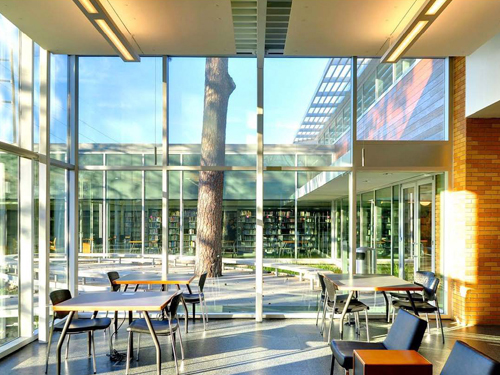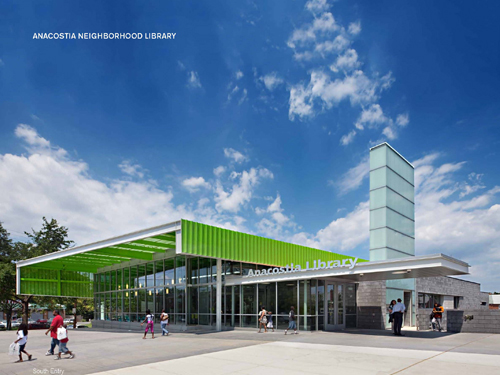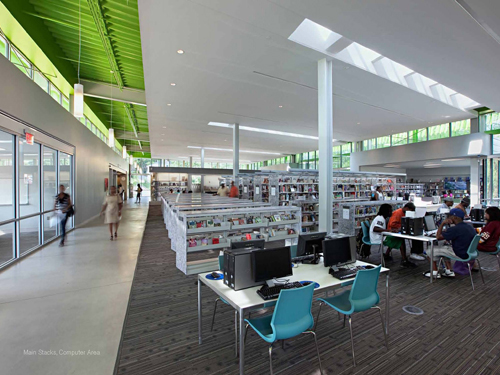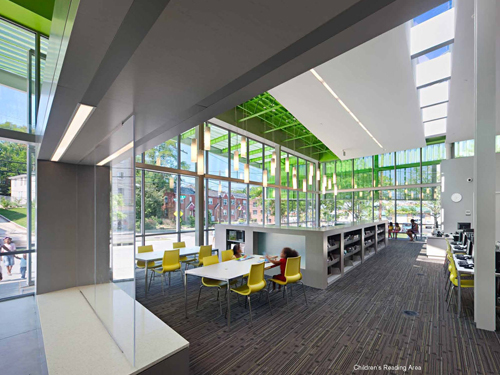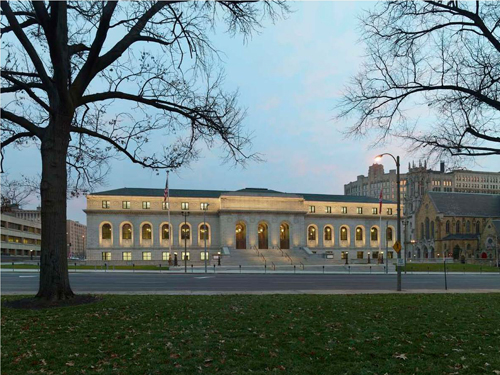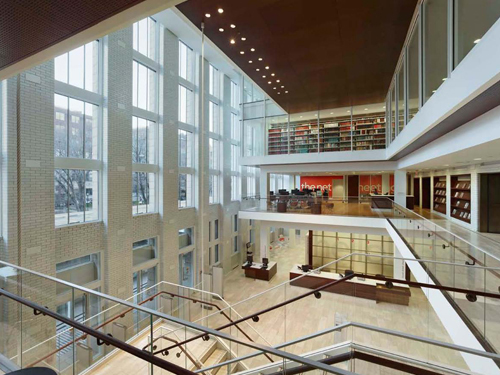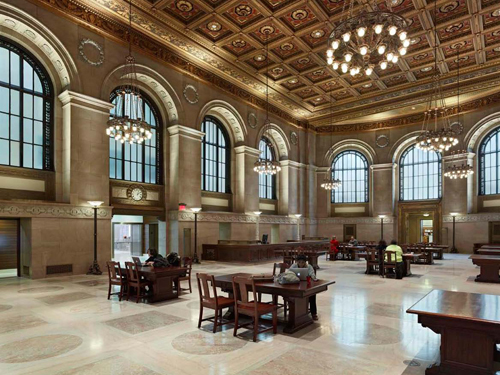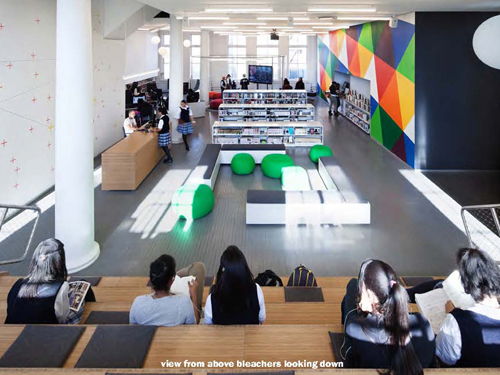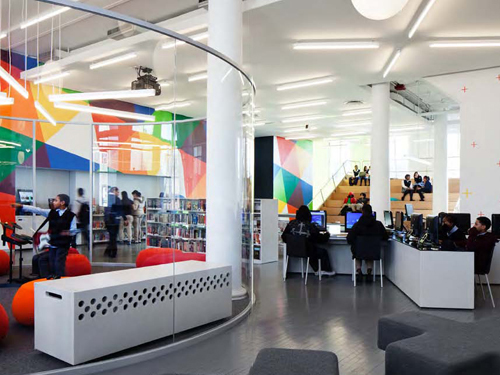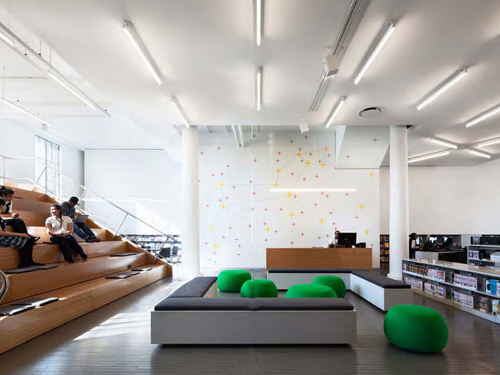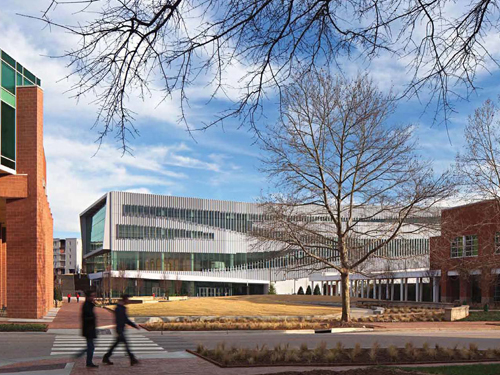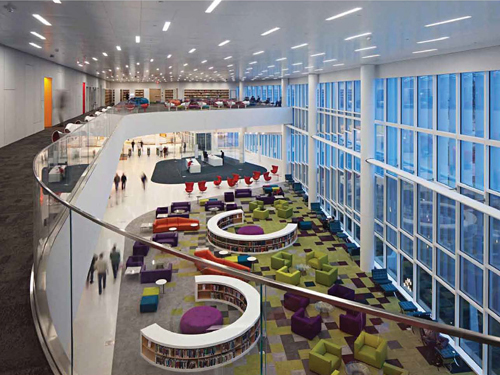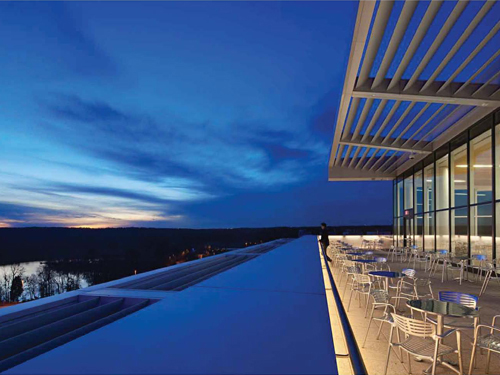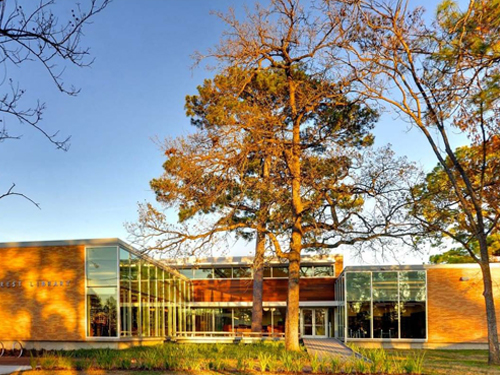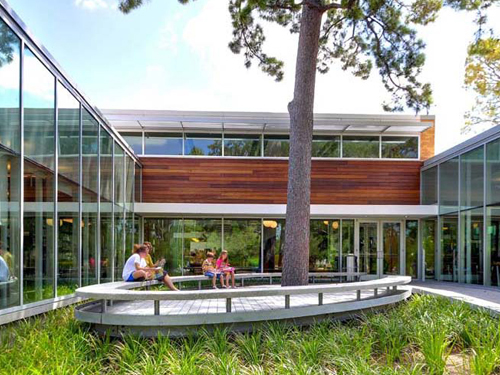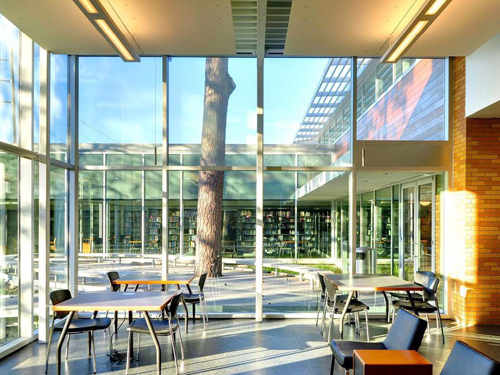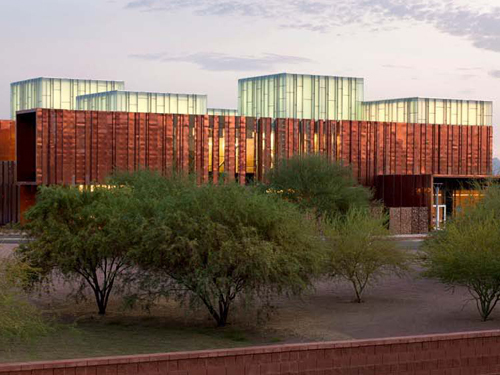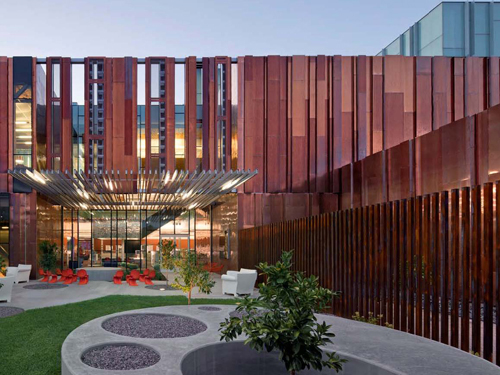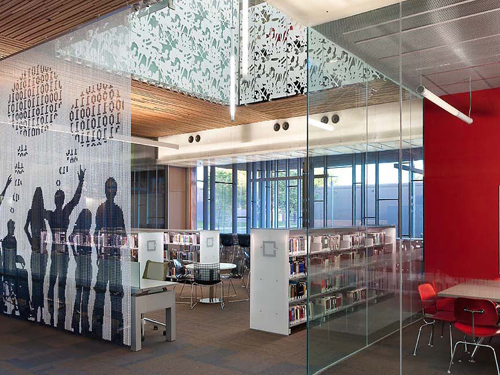The American Institute of Architects has selected six recipients to receive the 2013 AIA/ALA Library Building Awards. Biennially, representatives from the AIA and the American Library Association gather to celebrate the finest examples of library design by architects licensed in the U.S. The 2013 AIA/ALA Library Building Awards honor six separate projects.
The 2013 AIA/ALA Library Building Awards Jury includes: Jeanne M. Jackson, FAIA, Chair, VCBO Architecture; John R. Dale, FAIA, Harley Ellis Devereaux; Charles Forrest, Emory University Libraries; Kathleen Imhoff, Library Consultant; J. Stuart Pettitt, AIA, Straub Pettitt Yaste and John F. Szabo, Los Angeles Public Library.
The six winning projects are (images and descriptions courtesy AIA):
1. Anacostia Neighborhood Library; Washington, D.C.
The Freelon Group
The small-scale residential context provided the inspiration for the design of this new branch library, located in a low-income, underserved neighborhood in Washington, D.C. The project not only fulfilled programmatic needs but also provided a stimulus for community pride and economic development.
The residential scale is reflected in the library design as a series of pavilions for program areas that require enclosure: the children’s program room, the young adults’ area, support spaces, and public meeting rooms. The remainder of the level one plan is high, open space for the main reading room, stacks, computers, and public seating areas. A large green roof structure provides shelter over all program areas.
Community input was also a key part of the design process. Users made it clear they wanted an open, welcoming building. The large front plaza invites pedestrians to come in, and the floor-to-ceiling glass on all sides provides passersby a clear view into the building. The building and site work together as a classroom for sustainable features and education about ecological systems, including a rain garden. The project received LEED® Gold certification.
2. Central Library Renovation; St. Louis
Cannon Design
Cass Gilbert’s grand Beaux-Arts library, now 100 years old and a St. Louis cultural landmark, was in need of a transformative restoration that would increase public access and modernize it for the 21st century.
On the interior, the centrally located Great Hall is surrounded by five wings, four dedicated to public reading rooms and the fifth, the north wing, to a multistory book depository closed to the public. The transformation of the north wing truly rejuvenated the library and brought it into the next century. Old book stacks were removed, and a new “building within a building” was inserted. Now, a multistory public atrium provides an accessible and welcoming entry. The new “floating platforms” surround the atrium without touching existing interior walls. Glass-enclosed upper levels house the collection with compact high-density bookshelves. The windows of the north wall, now clear glass, bounce natural light deep into the interior and provide striking views.
The Great Hall and four public wings have been restored to their original splendor. Modern data and electric raceways, concealed in the floors, house up-to-date technology and allow future modifications. Interior restoration included cleaning, painting, and replacement of ornamental cast plaster ceiling sections removed in the 1950s. Lighting systems with contemporary and replica fixtures bring new life to the interior.
3. New York Public Library, Hamilton Grange Teen Center; New York City
Rice+Lipka Architects
The center, located on the previously empty third-floor space of Harlem’s Hamilton Grange branch library, designed by McKim, Mead and White, is NYPL’s first full-floor space dedicated to teens. In an effort to attract and engage neighborhood youth, the 4,400-square-foot space challenges the norms of library design. The light-filled floor is divided into specific zones that foster small-group interaction and socialization. Visibility is maintained across the entire floor.
Two programmatic elements—a 20-foot-diameter Media Vitrine and a bamboo bleacher—occupy the center of the space and work to define the seven zones between and around them. The vitrine’s open-top glass enclosure upends the notion that multimedia spaces must be dark, hyperisolated rooms. The bleacher allows views out to the street from the existing high south-facing windows and provides a sunny hang-out for a range of group sizes. Custom L-shaped lounge benches bracket this space and can be rolled away to allow for other uses and activities.
Natural light conditions, color, spatial conditions, and artificial lighting patters are used architecturally to create the small-scale zones. The zones include the X-Bar computer zone, Snack+Chat Niche (a first-time NYPL break from the near-sacred prohibition of eating and drinking), a Study Zone adjacent to the exam prep stacks, and a Highback Lounge, which groups teens together but maintains a sense of individual privacy.
4. James B. Hunt Jr. Library; Raleigh, North Carolina
Snøhetta and Pearce Brinkley Cease + Lee
An $11 million reduction in the budget for this library during the schematic design phase prompted the design, construction, and client teams to formulate a range of new ideas to maintain functionality and quality. The building would need to be highly programmed and reasonably versatile as well as comfortable and stimulating to visitors.
One innovation was the introduction of an automated book delivery system (ABDS), which effectively reduced the total area of the building by 200,000 gross square feet and allowed more space for collaboration and technology. The ABDS is supported by user-friendly browsing software that matches and even enhances the traditional pleasure of browsing a collection.
The design celebrates the power of chance encounter and recognizes the role physical space plays in the intellectual stimulation of users. Large open spaces connect all floors of the library, and the use of stairs is emphasized to ensure an interactive and social environment in-between more focused study areas.
Designed to LEED® Silver requirements, the building features abundant natural light and expansive views of the nearby lake. Fritted glass and a fixed external aluminum shading system help diminish heat gain and maximize views and ambient natural light. Ceiling-mounted active chilled beams and radiant panels provide heating and cooling. Rain gardens and green roofs manage storm water.
5. Oak Forest Neighborhood Library; Houston
NAAA + AWI + JRA
This 7,600-square-foot modern brick and glass structure opened in 1961. Fifty years later, there was still great nostalgia for the library’s mid-century modern design, but the building no longer met the standards of the Houston Public Library system or the needs of the surrounding neighborhood. The 2011 renovations and additions respect the character of the existing library and enhance its accessibility and functionality.
The original building’s restored signature green tile mosaic still graces the parking entry area on the north, but now the neighborhood is welcomed by a tree-shaded second entry and outdoor reading room framed by new dedicated adult and teen areas on the west. The original tile mosaic and globe light canopy of the old circulation desk were restored to create a toddler-sized reading nook. Each age group—from toddlers through teens and adults—now has appropriate facilities, furnishings, and technology. A new lobby and circulation space, lit by a continuous shaded clerestory, occupies the seam between old and new and unites the two entries.
The project exceeded the city’s sustainability goals and is only the second of its buildings to receive LEED® Gold certification.
6. South Mountain Community Library; Phoenix
richärd+bauer
The building integrates the varied uses of a contemporary public library with the needs of a state-of-the-art central campus library, allowing each to function both independently and collaboratively. The design is modeled after that of an integrated circuit, providing insulation between disparate functions and promoting interaction and connection between like functions and spaces.
The simple massing of the building is attenuated to focus views on the surrounding mountains and provide shade and transparency. The site was once home to fertile agricultural valleys and citrus groves, and the building consciously merges interior and exterior spaces to connect to the area’s rich history. A series of rooftop monitors and light shafts flood natural light into the first-level core. The rain screen, formed of bent planks of copper, calls to mind the pattern of an abstracted bar code. Variegated cedar strips reinforce the digital aesthetic of the building. Further echoing the design of a circuit board, building systems are organized and expressed within an internally lit independent distribution soffit.
Abstracted agricultural patterns are digitally imprinted on the skylight liners and laser-cut guardrails. Accessible flooring provides flexibility for power and data. The library includes a 200-seat meeting room, conference and multimedia center, high-tech classrooms, computer center, and a children’s area.
Related Stories
| Aug 11, 2010
Goettsch Partners wins design competition for Soochow Securities HQ in China
Goettsch Partners (GP) has been selected as the winning firm in the competition to design the Soochow Securities Headquarters, the new office and stock exchange building for Soochow Securities Co. Ltd. The 21-story, 441,300-square-foot project includes 344,400 square feet of office space, an 86,100-square-foot stock exchange, meeting rooms, classrooms, a cafeteria, and underground parking for 400 cars and 800 bicycles.
| Aug 11, 2010
RMJM unveils design details for $1B green development in Turkey
International architecture company RMJM today announced details of the $1 billion Varyap Meridian development it is designing in Istanbul’s new residential and business district, which will be one of the "greenest" projects in Turkey. The luxury 372,000-square-meter development on a site totalling 107,000 square meters will be located in the Atasehir district of Istanbul, which the Turkish government intends to transform into the country’s new financial district and business center.
| Aug 11, 2010
Urban Land Institute honors five 'outstanding' developments in Europe, Middle East, and Africa
Five outstanding developments have been selected as winners of the Urban Land Institute (ULI) 2009 Awards for Excellence: Europe, Middle East, and Africa (EMEA) competition. This year, the competition also included the announcement of two special award winners. The Awards for Excellence competition is widely regarded as the land use industry’s most prestigious recognition program.
| Aug 11, 2010
Design firms slash IT spending in 2009
Over half of architecture, engineering, and environmental consulting firms (55%) are budgeting less for information technology in 2009 than they did in 2008, according to a new report from ZweigWhite. The 2009 Information Technology Survey reports that firms' 2009 IT budgets are a median of 3.3% of net service revenue, down from 3.6% in 2008. Firms planning to decrease spending are expected to do so by a median of 20%.
| Aug 11, 2010
A glimmer of hope amid grim news as construction employment falls in most states, metro areas
The construction employment picture brightened slightly with 18 states adding construction jobs from April to May according to a new analysis of data released today by the Bureau of Labor Statistics (BLS). However, construction employment overall continued to decline, noted Ken Simonson, the chief economist for the Associated General Contractors of America.
| Aug 11, 2010
Thom Mayne unveils 'floating cube' design for the Perot Museum of Nature and Science in Dallas
Calling it a “living educational tool featuring architecture inspired by nature and science,” Pritzker Prize Laureate Thom Mayne and leaders from the Museum of Nature & Science unveiled the schematic designs and building model for the Perot Museum of Nature & Science at Victory Park. Groundbreaking on the approximately $185 million project will be held later this fall, and the Museum is expected to open by early 2013.
| Aug 11, 2010
SOM's William F. Baker awarded Fritz Leonhardt Prize for achievement in structural engineering
In recognition of his engineering accomplishments, which include many of the tallest skyscrapers of our time, William F. Baker received the coveted Fritz Leonhardt Prize in Stuttgart, Germany. He is the first American to receive the prize.
| Aug 11, 2010
American Concrete Institute forms technical committee on BIM for concrete structures
The American Concrete Institute (ACI) announces the formation of a new technical committee on Building Information Modeling (BIM) of Concrete Structures.


